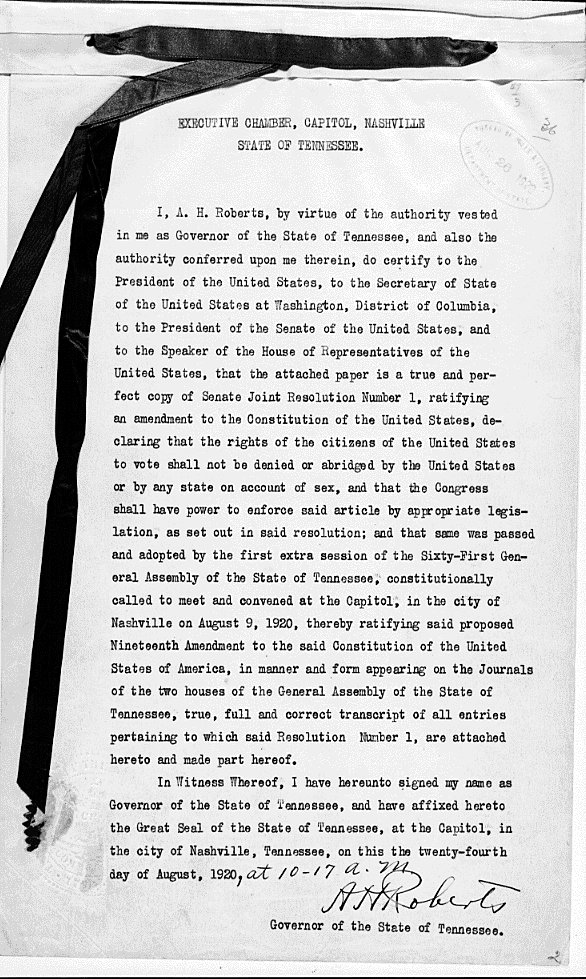The Seneca Falls Convention was the first woman's rights convention, which was held in July 1848 in Seneca Falls, New York. The meeting launched the women’s suffrage movement.
 Declaration of Sentiments and Resolution
Declaration of Sentiments and Resolution
Throughout 1915, the Congressional Union organized state branches, held national conventions of women voters and collected 500,000 signatures on a suffrage petition, to testify testified before Congress. In June 1916, CU’s leaders formed the National Woman’s Party.
 Voting rights petition sent to congress in 1871. Source.
Voting rights petition sent to congress in 1871. Source.
 Petition for Woman Suffrage Signed by Frederick Douglass. Source.
Petition for Woman Suffrage Signed by Frederick Douglass. Source.
After President Wilson’s reelection, Alice Paul (one of the leader of suffragist movement) called for National Woman’s Party to convince the president to put pressure on Democratic senators to vote in favor of a constitutional suffrage amendment.

 Suffrage Posters
Suffrage Posters
The Progressive Era was a period of social activism and political reform that took place from late 1800s to early 1900s. During the Progressive Era, individuals and organizations worked to solve problems caused by the Industrial Revolution, such as addressing the terrible living conditions of tenements as people flooded into cities for work in manufacturing. The Progressive Era was in some ways a response to the Gilded Age, a time which highlighted the vast difference in wealth between those who oversaw industry and the poor people who worked within factories. Along with industrialization and urbanization, came political machines which are political groups that reward supporters with jobs, pubic services, housing and many opportunities in exchange for votes. They increasingly controlled U.S politics, and big industries formed powerful nationwide trusts that controlled the U.S economy and Congress through bribes. One of NY’s most popular political machine was Tammany Hall, and it’s many leaders such as William M. Tweed, Richard F. Croker, and Charles F. Murray influenced politics. They were very popular among working class because of their willingness to help poor immigrants. The Irish is an example of political machines’ influence and power; Irish were admitted as members of Tammany Hall. As a result, The irish did not face any immigration discrimination; while the Chinese and Italians faced immigration restriction, the Irish climbed up the social ladder through political machine’s “rewards”. In short, Political machines and trusts created massive corruption in government.
 The Bosses of the Senate. Illustration by Joseph Keppler. 23 January 1889. Source.
The Bosses of the Senate. Illustration by Joseph Keppler. 23 January 1889. Source.
Once the United States entered World War I (1914-1918), women took over men’s jobs while men were at war. Women supported the war effort by growing food, working at munition factories, providing medical help, and more. Women’s contributions to the war effort also supported the suffrage movement; it proved women’s capabilities were equal to men’s.
 "National League for Women’s Service. Fall In!" poster. By Lucille Patterson. c. 1914-1918. From the Texas War Records War Poster Collection, Worle War I Posters Collection. Source.
"National League for Women’s Service. Fall In!" poster. By Lucille Patterson. c. 1914-1918. From the Texas War Records War Poster Collection, Worle War I Posters Collection. Source.
The suffrage movement faced a setback during the process of ratifying the 18th Amendment. The 18th Amendment prohibited alcohol and was an attempt to reestablish morality in America. The 18th Amendment was promoted by the temperance movements, led by women who based their dislike of alcohol on religious teachings. Some of these women felt out of place and were afraid that the focus on religion was fading away from America because of the Industrial Revolution and the Gilded Age. Women were viewed to be moral spheres in households, so men assumed that if women had suffrage, women would support and vote for prohibition of alcohol. Therefore, the 18th Amendment was a temporary setback for women’s suffrage movement.
 Kaiser Wilson Poster
Kaiser Wilson Poster
 Women suffragists picketing in front of the White House. Soure.
Women suffragists picketing in front of the White House. Soure.
In prison, women refused to comply with wearing prison uniforms or working assigned prison chores resulting, the guards to become violent, kicking and beating the prisoners, and this became known as “The Night of Terror.”
Suffragists then resorted to hunger strikes, and in response jailers began force-feeding women. Once the public learned about women suffragists’ treatment in prison, they were enraged and disgusted by the government’s conduct. Women were acting on behalf of their rights. With freedom of speech comes the right to protest, thereby arresting women for protesting is unconstitutional. Furthermore, force feeding prisoners brutally violates humans rights. The oppression of women won more public support for women’s suffrage. President Wilson was in dismay by the hunger strikes and worried about aspersion for his administration, so he finally agreed to a suffrage amendment in January 1918.
State legislators wore flowers of different colors that represented that they were for or against women's suffrage. A red rose signified opposition to women’s suffrage, and a yellow rose signified the legislator was in favor of women’s suffrage. State legislators were almost split in half, however at the last moment Harry Burn, a 24-year-old representative from Tennessee, changed his vote to for women’s suffrage. Even though Burn was wearing a red rose, a letter from his mother changed his vote. His mother wrote, “Vote for suffrage! Don’t keep them in doubt...don't forget to be a good boy.” After his vote, he explained, “I know that a mother’s advice is always safest for her boy to follow...and my mother wanted me to vote for ratification.”
Harry Burn's Letter From His Mother
Tennessee became the 36th state to ratify the amendment on August 18, 1920. The amendment passed the last obstacle obtaining the agreement of three-fourths of the states.
 Ratification Of The 19th Amendment
Ratification Of The 19th Amendment